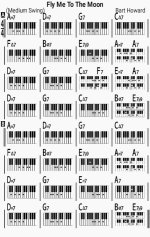If a Am7 is played in 2nd inversion, shouldn't there be "Am7/E" in the leadsheet instead of just Am7?
Thanks, but I don't understand why not alway the root chord is displayed...
You might want to talk to your teacher about all this. You will be paying for your teaching sessions. There is so much to learn as you know (endless!) and your teacher will be able to guide you efficiently in your learning. Using the tools in iReal Pro are very helpful but do not get so side-tracked that you are not getting the most out of your teacher’s lessons and recommended practicing.

As a general rule, it is good to be able to move your left hand fingers so they move nearby to the next chord’s notes. For example A C E (bottom to top) would go to A D F (the A note staying the same). Or if you start the Am with first inversion, C E A, then the Dm would be D F A. Minimal movement of hand and fingers (and notes to the next group of notes).
Although you can loop in iReal Pro, you might find it helpful to make a new song just with perhaps two chords you are practicing (one per measure at least). Once you choose a diagram (root or a specific inversion), each time that measure is played, it will show for you. Choose a slow tempo. You need to know the notes in your mind, but your fingers will need to develop their own muscle memory in order to do this automatically. You can slowly work through different chord progressions of the song over a number of weeks. You need fluency at slow tempos before you can play through these exercises gradually faster, and this can take time practicing regularly (frequently throughout the day for a few minutes is better than a long session every couple of weeks).
Your teacher might recommend just learning one voicing of each chord as a starting point just so your fingers get used to the movements (shapes) they need to make to execute the chord progressions. Learning a complete song such as Fly me to the Moon at once is quite ambitious (but I do not know your exact skills).
Moving on from a couple of chords, try the first four bars (or the next two). Again, a practice song of just the first four chords only would be useful for practice. And slow tempos so your fingers learn where to go, and only one way of voicing the chord, until your fingers learn it automatically.
Save the song so when you need to learn different voicings of the same chords, you do not need to set it up again.
There are many chord qualities, inversions for each and keys. Your fingers can get a little confused if you learn too many at once and the muscle memory you require will not develop quickly.
—
When you read notation, the exact notes for the chord are specified (whether they have the root at the bottom or inversions). With chord symbols, the inversions are not usually specified, the voicings are up to you. (Sometimes a pianist will play the inversions if they are indicated, but if there is a bass player, you usually do not need to).
Do not play them too low because it sounds muddy. Learning to play the voicing just below middle C (perhaps a little above that for a few notes of the voicing) is where I would recommend as a starting point (and not too much lower than the C below that). This means it is out of the way of the melody or solo in the right hand and not sounding muddy. When I do this, I need to know the inversions of each chord as it comes along so my hand does not jump around much. If I played every chord at root position, my hand would be jumping around a lot, whereas it has a nice aural and physical flow if I move my fingers minimally to get the next notes near where my hand already is so it does not disturb anything sonically to distract from what the right hand is doing. (Obviously this is not done all the time once you are proficient, but I would recommend it as a goal - going towards this in your practice sessions). You cannot learn all inversions for all the chords at once, so your teacher will be able to guide you how to approach this.
I hope something here helps what you are thinking about.

